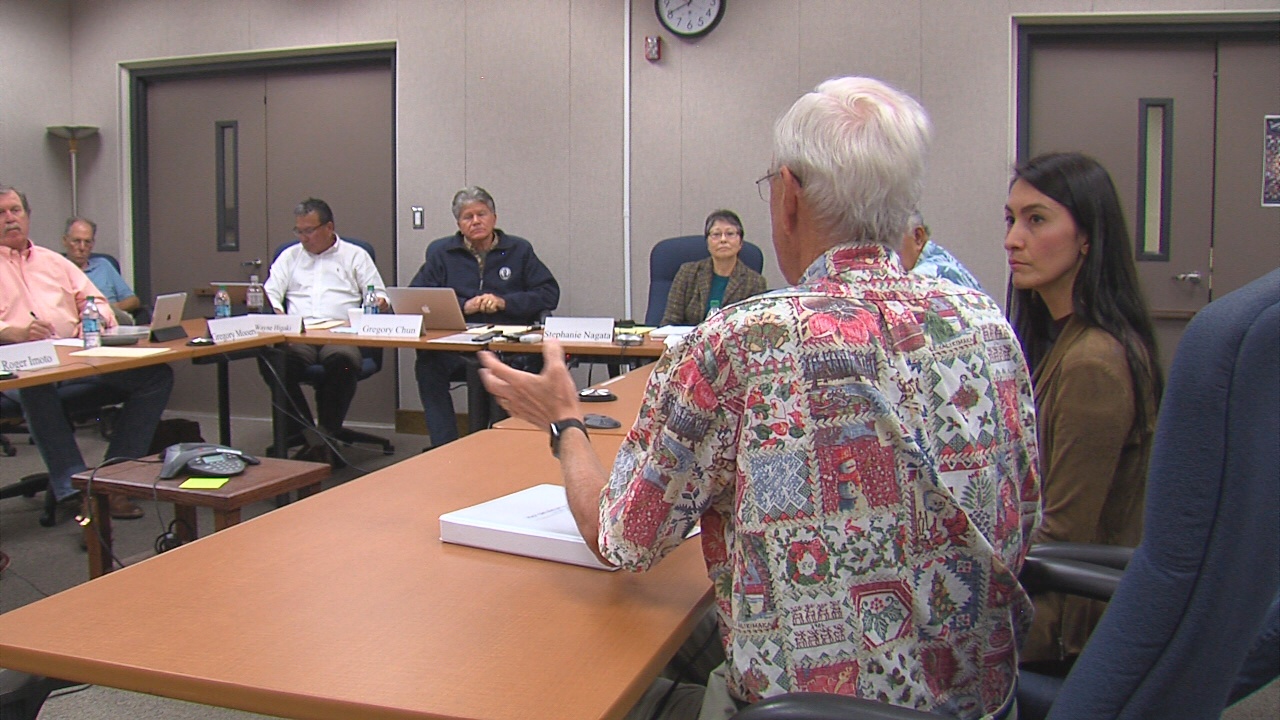
Peter Young addresses the Mauna Kea Management Board in Hilo.
(BIVN) – The Mauna Kea Management Board met in Hilo on November 28, where – for the first time – board members heard from consultants retained to begin the decommissioning process for the Caltech Submillimeter Observatory on Mauna Kea.
“The status is that its moving forward,” Peter Young of Ho‘okuleana LLC – one of the consultants hired to handle project planning, permit applications, communication, and community outreach – told the board. “You’re gonna read about it shortly, and we wanted to tell you before you read about it.”
Board members expressed to Young how essential it is, as the first decommissioning of an observatory on Mauna Kea, that everything be done right and by the book.
This media release was issued by the project team on Monday:
Public Input Sought on Removal of Caltech Submillimeter Observatory from Maunakea
(PASADENA, CALIFORNIA, DECEMBER 4, 2017) – Caltech is proceeding to decommission the Caltech Submillimeter Observatory (CSO) on Hawaii Island’s Maunakea. CSO began operations in 1987 and ceased scientific observations in September 2015.
The next steps are an environmental assessment (EA) and a conservation district use application (CDUA). A “public scoping period,” open until January 15, 2018, is the first opportunity the community will have to comment on removal and site restoration. There will be additional opportunities, including formal comment periods, once the drafts of the EA and CDUA are released.
The Office of Maunakea Management (OMKM), which is part of the University of Hawaii at HiIo, will coordinate procedures for this process. The C50 is the first telescope to be removed from the mountain under the Decommissioning Plan for Maunakea Observatories, a sub-plan of the Maunakea Comprehensive Management Plan, which aims to protect the cultural, natural, and scientific resources of the area.
As part of the EA, Caltech is preparing plans that include scenarios for observatory deconstruction, removal, and site restoration, all in accordance with its sublease with the University of Hawaii and the Decommissioning Plan.
Community input and analyses of the cultural, environmental, and financial benefits and impacts of the various scenarios will help determine the appropriate level of removal and site restoration, and future use of the site. Final plans require approval by Caltech, the Maunakea Management Board, the University of Hawaii, and the state Department of Land and Natural Resources (DLNR).
When the EA process is completed, a CDUA will be filed with DLNR. The state Board of Land and Natural Resources will decide whether to issue a conservation district use permit (CDUP). According to the Decommissioning Plan, once the CSO is removed and the site is restored, the site will not be used for future observatory development.
We are grateful for the use of Maunakea for nearly three decades for astronomical research,” says Sunil Golwala, director of the CSO and a professor of physics at Caltech. “We are undertaking the decommissioning process respectfully and look forward to working with OMKM, University of Hawaii at Hilo, and the community.”
Caltech selected the team of M3 Engineering, Ho’okuleana LLC, and Hastings & Pleadwell: A Communication Company to handle project planning, permit applications, communication, and community outreach related to the CSO decommissioning.
More information is available at cso.caltech.edu. The community is encouraged to submit comments to Peter Young of Ho’okuleana LLC (PeterYoung@Hookuleana.com) by January 15, 2018.
About the Caltech Submillimeter Observatory
The CSO served from 1987 to 2015 as a leading facility for astronomical research and instrumentation development. The observatory played a foundational role in creating submillimeter astronomy-the study of light emitted by atoms, molecules, and dust grains in the interstellar space where stars and planets form.

by Big Island Video News7:07 am
on at
STORY SUMMARY
HILO, Hawaii - Last week, Mauna Kea Management Board members heard from consultants retained to begin the decommissioning process for the Caltech Submillimeter Observatory.